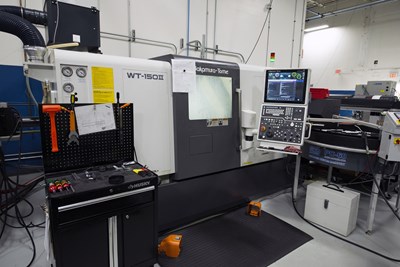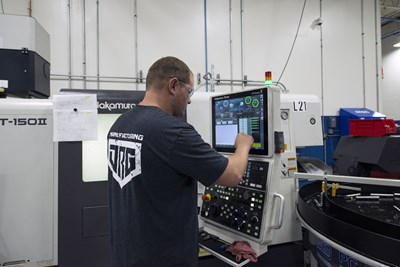Turning Machines Help Firearms Supplier Achieve Rapid Growth
Appears in Print as: 'Turning Machine Line Leads to Success of Firearms Supplier'
Working closely with its machine tool supplier, this firearms manufacturer has quickly expanded its lineup of turning machines to deliver quality products and faster delivery.
When a shop is created to serve a specific market, it can focus on this core competency from the start, encouraging all efforts to strive for the main goal. This shop in Lake Zurich, Illinois, did just that, opening its doors only a few years ago with the sole objective of becoming a full firearms manufacturer.
DRG Manufacturing began its operations in 2016 with only five employees working a single shift. In only a few short years, the company has grown to 38 employees running two manned shifts, along with a third shift of automated cells and lathes with bar feeders running unattended.
From the Ground Up
According to Dave Rybacki, company owner (or head janitor if you go by what his business card says), what helped the company quickly establish itself in the firearms market was being able to work from scratch in equipping the shop floor. “We weren’t a job shop with 50 machines on the floor that suddenly decided to go make firearms components,” he says. It’s not always a smooth transition to repurpose existing machines to make these parts competitively. Instead, from the company’s early days, it was able to buy what it felt were the best machines for the parts, incorporating the newest technology into the field.
When it comes to machine tool purchases, DRG is immediately drawn to Methods Machine Tools Inc. (corporate headquarters in Sudbury, Massachusetts). “We have a tight relationship with Methods,” Mr. Rybacki says. While growth has been steady and with purpose, the company has gone from its early days with only a couple of machines to almost filling its shop floor with 10 different Nakamura-Tome machines supplied by Methods’ Elgin, Illinois, office. "Working the sales, engineering and service teams from Methods has helped facilitate the rapid growth we’ve experienced," Mr. Rybacki continues.
The first transaction between the two companies involved an automated cell to run a gas key—a component located on top of the carrier of a gas-fed rifle that allows the rifle to cycle. The company initially tried to run the part on a Swiss machine, but it was ineffective, resulting in excessive tool failure and missed delivery dates. DRG turned to Methods for a Fanuc RoboDrill automated cell solution, which moves the workpiece between two different ops. “With much of the part being milled, this cell brings additional benefits over a Swiss machine or lathe, such as tool checking,” Mr. Rybacki says. Now the company has more than 12 RoboDrills making different components, 10 of them in turnkey automated cells designed and built by the team from Methods’ Elgin Office.
Supporting Growth
Today, the Nakamura-Tome machines on DRG’s floor include two WT-150 and two WT-250 dual-turret multitasking turning centers; a WY-150 twin-spindle, two-turret multitasking machine with Y axis; a NTY3-100 and three NTY3-150 three-turret, three-Y-axis multitasking machines; and one AS-200 turning center.

The Nakamura-Tome WT-150 immediately cut cycle time by more than 20% over the previous machine without any program changes or adjustments to speeds and feeds.
The first of these machines that the company implemented—the WT-150—is set up to run M-16 carrier blanks from 8620 AQBQ (aircraft quality, bearing quality) steel. After the ODs and IDs are run, the blanks are moved to the robotic mill cell for finish operations. The cell produces about 15,000 carriers per month.
That first WT-150 has been dedicated to carrier blank production since it was brought in. It replaced a different heavy-duty turning center, and without any program changes or adjustments to speeds and feeds, it immediately cut the cycle time from 4.5 to 3.5 minutes. “Taking a minute out of the cycle time like that for doing nothing but changing the machine was pretty incredible to us,” Mr. Rybacki says.
Shop Manager Joe Marzano explains that along with faster rapids, chip to chip time is faster because the turrets do not need to be sent home for indexing. The faster production time has had a significant impact, but another feature that the operators appreciate is the robotic parts grabber that pulls the part out of the spindle. “Everything is faster, but in the past, with other machines, we’ve struggled with parts ejectors. The parts grabber has made a big difference,” Mr. Marzano says.

The Smart X control, available on all the Nakamura-Tome machines, features a 19-inch LCD touchscreen control and minimizes paperwork by providing accessibility to prints, setup sheets, quality control reports and tool lists.
The operators also feel that the Smart X operating system on the 19-inch LCD touchscreen Windows-based control has added great benefits. Smart X is available on all the Nakamura-Tome machines, so the uniformity throughout the entire shop simplifies operations. Prints, setup sheets, quality control reports and tool lists are all accessible at the control to minimize paperwork and simplify organization. “The Nakamuras are very user-friendly machines,” says Bruce Van Dyke, lathe department manager. “It’s easy for any machinist to step right in at any machine. The tool macros and program editing capabilities simplify what used to be far more complex tasks. And we haven’t even begun to scratch the surface of the full capabilities of these controls yet.”
Currently, each of DRG’s Nakamura-Tome machines has a dedicated USB drive that stores prints, inspection plans, bubble drawings, setup sheets, and other important documentation. These drives are used to load updated data to the machines. DRG is partnering with Methods to connect each of these machines to the company network to further facilitate tracking of uptime, downtime, parts per hour and so on.
A Look to the Future
DRG continues to grow, and Mr. Rybacki says some exciting changes are soon to come. He says by the end of 2019, the company will be a total solutions provider for the AR-10 and AR-15 platforms. “As a manufacturer for OEMs, the only thing we won’t make in house will be triggers, springs and plastics,” he says. Each month the company manufactures 20,000 bolts; 15,000 carriers; 10,000 gas keys; and 2,000 lowers and uppers from billet. It also has the capability to run as many as 4,000 handguards per month. “Many of our customers are narrowing their vendor lists and have been asking us for more capacity on certain items. We are earning their business because we pride ourselves on our delivery. We’ll happily keep things in stock and put more inventory on the floor than most companies,” Mr. Rybacki says.
The company has been on a rapid growth path since opening, more than doubling gross revenue each year. Mr. Rybacki says he will likely be adding more machines soon, continuing the company’s expansion. For this firearms supplier, business is booming!
RELATED CONTENT
-
Advancements in Thread Whirling Tooling Technology
Many understand the advantages of thread whirling on a CNC Swiss-type. However, new tooling technology for this thread-machining process can further improve cycle times and reduce cost per part.
-
Hard Turning as an Alternative to Grinding
Hard turning can be a cost effective alternative for shops looking to streamline part processing.
-
VIDEOS: Tips for Screw Making on Swiss-Type Machines
Here’s a three-part video series focused on Swiss screw making to help explain the benefits of thread whirling, back turning and broaching while taking into consideration CAM programming, tooling and machine specifications.



